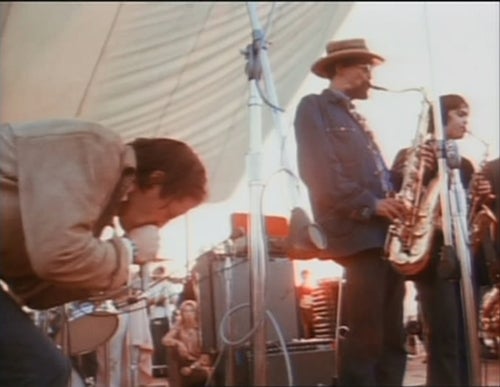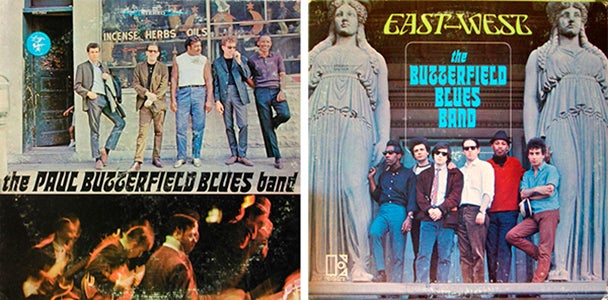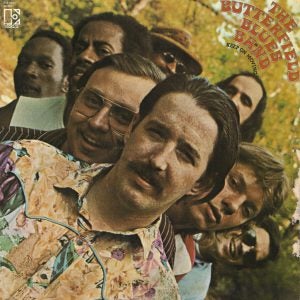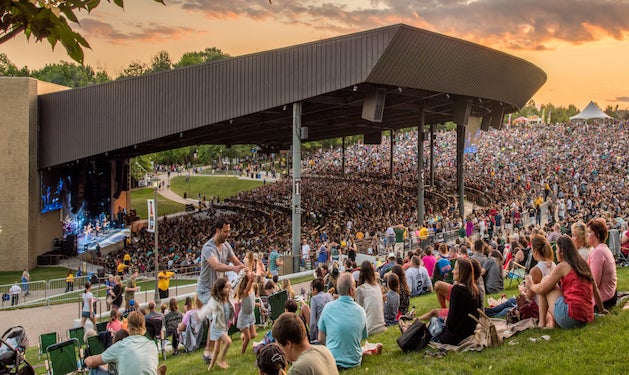The Paul Butterfield Blues Band: 50 Years of Peace & Music
In the early hours of Monday morning, blues harmonica (or harp, in the parlance of the genre) great Paul Butterfield and his band performed a set of horn-based, soul-influenced blues for the exhausted audience. By that time, many of the attendees had left the festival, returning to their workweek or stumbling home for a shower and some rest.
Celebrating the 50th anniversary of the Woodstock festival, August 1969–2019
Day Three, Performer 8: The Paul Butterfield Blues Band
Performed Monday morning, August 18, 6:00–7:15 am

The Paul Butterfield Blues Band Members
- Paul Butterfield: harmonica, vocals
- Buzzy Feiten: guitar
- Steve Madalo: trumpet
- Keith Johnson: trumpet
- Gene Dinwiddie: tenor saxophone
- David Sanborn: alto saxophone
- Trevor Lawrence: baritone saxophone
- Teddy Harris: piano
- Rod Hicks: bass
- Phillip Wilson: drums
The Paul Butterfield Blues Band Woodstock Setlist
- Born Under a Bad Sign
- No Amount of Loving
- Driftin' and Driftin'
- Morning Sunrise
- All in a Day
- Love March
- Everything's Gonna Be Alright
Paul Butterfield is widely acknowledged as one of the greatest blues harp players of all time. He grew up in Chicago, where he studied classical flute with Walfrid Jujala of the Chicago Symphony Orchestra. While still a teenager, he began going to blues clubs in Chicago, where he listened to—and sometimes sat in with—the likes of Muddy Waters, Howlin’ Wolf, and Otis Rush. While attending the University of Chicago in 1963, he befriended guitarist Elvin Bishop, and they began doing blues gigs as a duo, eventually adding bassist Jerome Arnold and drummer Sam Lay, both from Howlin’ Wolf’s band, to join the group.
While performing a residency at a Chicago club called Big John’s, Butterfield and his new group caught the attention of Paul Rothchild, a record producer who would go on to become famous as a house producer for the Elektra label, producing hugely successful albums for The Doors among others. Rothchild persuaded Butterfield to bring a brilliant blues guitarist named Mike Bloomfield, who had been jamming with the group at Big John’s, into the band as a full member. After signing the Butterfield Blues Band to a deal with Elektra Records, Rothchild set out to record their first album. After two failed attempts to record an album that the producer felt was good enough to release, the band was booked to perform at the 1965 Newport Folk Festival. Another performer at that festival, Bob Dylan, heard the band perform during a blues workshop at the festival and invited Mike Bloomfield, Jerome Arnold and Sam Lay to play backup for his set. The resulting four-song set the next day was Dylan’s famous first electric performance, which some festival attendees (mostly folk music purists) loudly booed, but which instantly changed the course of music history.
After Newport, the band added Mark Naftalin on keyboards and went into the studio to take a shot at recording their debut album. This was finally deemed good enough to release, and The Butterfield Blues Band was duly released in October 1965. The collection of upbeat blues tunes charted at #123 and, despite poor sales, was quite influential among other aspiring blues musicians. 1966 saw Butterfield replacing Sam Lay with jazz drummer Billy Davenport. This switch influenced a shift in musical direction that was reflected on their second album, East-West, which was released in August 1966. This album expanded the band’s reputation and included Indian rāga influences and early experimentations with jazz-fusion and blues-rock.

The next two years saw the band recording and performing while undergoing a number of personnel changes. 1967 saw the departures of Jerome Arnold and Billy Davenport, who were replaced by bassist Bugsy Maugh and drummer Philip Wilson. The band also expanded to include a horn section with the recruitment of saxophonists David Sanborn and Gene Dinwiddie. Once again, the personnel changes influenced a shift in the band’s musical direction, this time toward R&B. This melding of R&B and Chicago blues was reflected in the group’s third album, The Resurrection of Pigboy Crabshaw, which was released in December 1967 and would become the band’s highest-charting LP ever, reaching #52.
The fourth Butterfield Blues Band album, In My Own Dream, was issued in July 1968 and saw the band stretch even further into R&B territory. It also saw Butterfield taking more of a back seat vocally, as his bandmates were given more time in the spotlight. More personnel changes followed the album’s release with the departures of Elvin Bishop and Mark Naftalin. They were replaced respectively by a hot young blues guitar slinger named Buzzy Feiten and keyboardist Ted Harris. Bassist Bugsy Maugh also dropped out, and was replaced by Rod Hicks. The horn section was also expanded to include Steve Madalo and Keith Johnson on trumpet as well as Trevor Lawrence on baritone sax.
By the summer of 1969, the Paul Butterfield Blues Band was a nine-piece band playing Chicago blues and R&B with a five-piece horn section, and with Paul Butterfield as the only original member. Their fifth studio album, Keep On Moving, was released in May 1969 and, even if it continued the band’s commercial slide, showed the band as a tight and punchy outfit. They were regulars on the festival circuit going back to a well-received performance at the 1967 Monterey International Pop Festival, and so they were a natural fit for the Woodstock stage.

With the sun rising on what would be a glorious day weather-wise, Woodstock headed into the home stretch with some early morning blues courtesy of the Butterfield Blues Band. Even if the band was surely quite tired by the time they hit the stage, they managed to turn out an energetic set for the bleary-eyed remaining denizens of Woodstock Nation. They opened with a cover of Albert King’s “Born Under A Bad Sign,” which the group had recorded for their 1967 album The Resurrection of Pigboy Crabshaw. A tune from their recent album Keep On Moving followed with the Butterfield original, “No Amount Of Loving.” One of the high points of the set came with a brilliant take on the blues standard “Driftin’ And Driftin’” (also from Pigboy Crabshaw), with brilliant solos taken by guitarist Buzzy Feiten and Butterfield himself.
Three more tunes from Keep On Moving closed out the main set. The first was the wholly appropriate Butterfield original “Morning Sunrise,” with the horn section sounding exultant. Bassist Rod Hicks’ “All In A Day” kept things peppy before the microphone was handed over to sax man Gene Dinwiddie for the love-and-peace, of-its-time anthem “Love March.” Unfortunately, the crowd was not in much of a mood to march, though they responded to Dinwiddie’s soulful breakdown sections with some of the biggest cheers of the set. For their encore, the band whipped out a sweet version of Little Walter’s “Everything’s Gonna Be Alright,” Butterfield pumping up the muddy but delighted throng with some serious harmonica wailing.
The band continued to tour after Woodstock, issuing the 2-LP set Live in 1970. After the 1971 release of their sixth studio album Sometimes I Just Feel Like Smilin’, the Paul Butterfield Blues Band broke up. Butterfield relocated to Woodstock, New York and put together a new band, Paul Butterfield’s Better Days, which lasted for two years. He then pursued a solo career, playing with Muddy Waters, and various members of The Band among others. He died of a heroin overdose in 1987.
Guitarist Buzzy Feiten joined The Rascals for a time, after which he turned to session work and manufacturing solid-body guitars. Trumpeter Keith Johnson left the group in 1970 and became a member of New York “street” band Elephant’s Memory while also doing session work. Tenor saxophonist Gene Dinwiddie played with Full Moon, B.B. King, Melissa Manchester, Jackie Lomax, and Gregg Allman before his death in 2002. David Sanborn continues to have a successful Grammy Award-winning alto saxophone career, both as a member of the Saturday Night Live house band and as a solo artist and with other artists, including Stevie Wonder, The Rolling Stones, David Bowie, Paul Simon, and James Taylor.
Baritone saxophonist Trevor Lawrence recorded several solo albums and works as a composer, performer, and arranger. Ted Harris went on to be musical director for The Supremes for 16 years and was the artist in residence at Highland Park School System in Michigan before his death from prostate cancer in 2005. Bassist Rod Hicks worked with a number of artists before his death from cancer in 2013. Drummer Phillip Wilson collaborated with a number of musicians and was murdered in New York City in 1992.
—Wade Lawrence & Scott Parker
